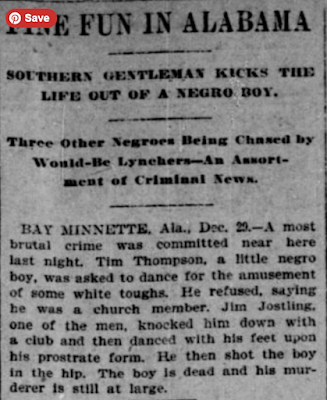Here's the latest batch of links to just-published Alabama history and culture articles. Most of these items are from newspapers, with others from magazines and TV and radio station websites. Some articles may be behind a paywall. Enjoy!
| October marks the 5th annual 'Huntsville History Month' | WHNT.com WHNT From the U.S. space program to being the beginning of Alabama's statehood, Huntsville has plenty of history. This year's format focuses on 4 ... |
| Vonetta Flowers headlines second Dr. Wilson Fallin Jr. Lecture Series at University of Montevallo Alabama NewsCenter Vonetta Flowers was the first Black woman in history to win a gold medal ... In 2011, Flowers was inducted into the Alabama Sports Hall of Fame. |
| West Alabama haunts: These locations have some creepy histories - WVUA 23 WVUA 23 But even if you don't, ghost stories contain a whole lot of history. So here's a look at some places around Tuscaloosa that just may be holding a ... |
Montgomery sites receive historic preservation funding - WSFA WSFA $469,500 to the Alabama Historical Commission for stabilization and preservation of the Schooner Clotilda in Mobile, the Last-known Slave Ship to ... |
| Inside Sean of the South's sweet, historic Alabama home - al.com AL.com Inside Sean of the South's sweet, historic Alabama home. Published: Oct. 06, 2022, 8:41 a.m.. 30. At home with Sean and Jamie Dietrich. facebook. |
| Sewell to announce major historic preservation funding for Selma Alabama Political Reporter Selma University, the Historic Brown Chapel AME Church and the ... the NPS Historic Preservation Fund to preserve Civil Rights sites in Alabama ... |
| Funding needed for Perote Colored Cemetery | News | unionspringsherald.com Union Springs Herald ... Colored Cemetery, Inc. is a non-profit organization in Perote, Alabama. The cemetery dates back to 1853, and numerous Civil War Veterans are ... |
| Tuskegee's Student Uprising: The Overlooked History | Time Time "The Tuskegee Student Uprising: A History" zeroes in on the 1968 uprising at Alabama's Tuskegee Institute, now Tuskegee University, that won ... |
| A Eugenics Program Masquerades as a Health Clinic in This Eye-Opening Historical Novel BookTrib In the small southwest Alabama town called Hyssop, during the hot, dry summer of 1968, a free women's health clinic opened. |
| Alabama author Ramona Reeves comes home with award-winning debut - al.com AL.com Knowing that Mobile native Ramona Reeves won a noteworthy literary prize for her new book, and that the prize had a sizeable monetary component, ... |
| State poet laureate announces creation of Alabama Poetry Delegation - al.com during the Magic City Poetry Festival (Shauna Stuart| Al.com). [Related: In her debut book of poetry, Alabama writer Tania Russell unpacks the ... |
| Deadline to nominate historic Alabama "Places in Peril" extended to Oct. 31 HISTORIC PRESERVATION ALERT: Do you know of a historic place in Alabama that needs saving? |














